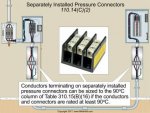mstrlucky74
Senior Member
- Location
- NJ
When sizing conductors and temp ratings at terminals on both ends are 90 degree you can use 90 degree column correct?
Sent from my SM-N960U using Tapatalk
Sent from my SM-N960U using Tapatalk

